On Gaza's border, potato farmers hope to lay groundwork for peace
Loading...
| Kibbutz Nahal Oz, Israel
Their homes lay less than two miles apart across fields of fertile earth, but they have been separated by years of war and military blockades.
Eid Siyam is a 38-year old resident of the Gaza City neighborhood of Tuffah. Many of his neighbors were left homeless or killed in Israel’s bitter 2014 war with Hamas, the Islamist rulers of the densely populated Palestinian territory.
Yankele Cohen is an 81-year-old founding member of Kibbutz Nahal Oz. The collective community nearly emptied of residents in 2014 after mortars fired from Gaza killed a 4-year-old in the yard of his family’s home.
Both men, farmers, saw their fields ripped up during the fighting.
But last week, just a few hundred feet from the opening of a cross-border tunnel used by Hamas fighters to ambush and kill Israeli soldiers, the two were trudging together through rows of crops at Nahal Oz, digging up potatoes from the cool, moist soil. Instead of politics, the conversation focused on the details of potato farming: irrigation, disease, seeding techniques, and crop yields.
It’s a rare example of cross-border agricultural cooperation in a region that has suffered from three wars since 2008 and where fears of a new outbreak of fighting persist.
Mr. Siyam is one of a handful of Gaza potato farmers who in the last half year have been crossing into Israel to consult with Mr. Cohen on how to improve growing techniques, which new strains to experiment with, and how to build Gaza’s first French fry factory.
“All the sides lost in the war; it’s a very bad situation in Gaza – it affected everyone. I’m interested in getting back to work,” says Siyam, whose fields lie near an Israeli military buffer zone on the border of the northern Gaza Strip. “Now, God willing, we are ready to start planting. Later on, we can continue the cooperation and make a big factory for French fries.”
Pressure from the people
The connection between the Palestinian farmers and Cohen, an international expert nicknamed “Mr. Potato” in Israel, was made through the United Nations Food Agriculture Organization and the Israeli Defense Ministry’s liaison office to Gaza.
Cohen has advised growers in Egypt, Kazakhstan, and China, but until last year had never worked with the Palestinians living just across the border. Recurring war and instability, Cohen says, demonstrate the importance of helping rebuild Gaza’s economy. Kibbutz members fear that another round of fighting will prompt young families to leave the collective.
“People understand that if there’s positive activity [in Gaza], and they have something to earn a living from, it can only help. There is 50 percent unemployment over there,” says Cohen.
“I believe, and I’m not the only one, that pressure of the people from below – both on our side and on theirs – will bring the leaders to understand that it’s necessary to create a more normal situation in which we can live together,” he says. “The big agreements, they can leave for the future.”
After a year of quiet, the border area has again become tense: dozens of Gazans staged demonstrations there in October and tried to cross into Israel; Hamas recently boasted of digging new cross-border tunnels under the frontier, and the Israeli army keeps a close watch for Palestinian infiltrators. In recent weeks, the army said it had sprayed herbicides near the border, which Palestinian officials say damaged 293 acres of land.
Agriculture's vital role
Agriculture is a key component of the economy for both Gaza and Israel, and it also plays a role in the conflict. For 1.8 million Gazans, it’s one of the leading sectors of an economy hemmed in by blockades imposed by Israel and Egypt. Some 19,000 households rely on farming.
Israel only allows Gaza’s tomatoes and eggplants into its markets, and exports of fruits and vegetables to the West Bank were only permitted after the 2014 war. Cross-border cooperation between merchants or in crop cultivation has been almost non-existent since Hamas took over the territory.
“This is a good opportunity to learn about modern growing technology,” says Mohammed Hassan, a Gaza agriculture expert who works for international aid agencies and was visiting Nahal Oz with Siyam. “It will help the farmers, most of whom live under the poverty line.”
According to the UN, the 2014 fighting cost Gaza’s agriculture sector an estimated $500 million in damage and 43 percent of its production capacity.
Siyam says he’s been slow to rehabilitate his land because it lies in the military buffer zone. “The land has been damaged, and it hasn’t been safe to go out to the land. We are afraid to make a problem,” he says. “I lost all of my business, and now I’m starting back again.”
A natural connection
Nahal Oz was the first of a handful of agricultural collectives established by Israel around the Gaza Strip to help secure the border. Cohen remembers when members were required to have escorts to work the fields for fear that the access roads had been mined by the Egyptians who then controlled Gaza.
He also remembers, after Israel conquered Gaza in 1967, how the border opened up to Israelis who shopped in Gaza markets and to Palestinian laborers who found work on Israeli farms. In the last 15 years, the kibbutz population has dwindled as it has become a target for frequent mortar and rocket fire. Residents are especially disturbed by reports of new tunneling.
Despite the potential grievances, the chatter in the fields last week was professional and cordial, with the farmers speaking in English and Hebrew about harvest dates, drip irrigation, and potato disease.
“The connection [between the farmers] flows naturally,” says Cohen.
Siyam says he planted his fields this month with the strains suggested by Cohen, and hopes the veteran agronomist can help get a French fry production line built. “We hope to finish all the problems between us, God willing. It’s not good for either side,” he says. “God willing, it will be a good season.”
After the tour of the fields, the Gazans gathered with Cohen and a kibbutz colleague in a conference room. Over Turkish coffee, both sides expressed hope that one day the border would open up. Until then, they darkly joked, there were always short cuts through the tunnels.






